
Economic views
The high cost of low growth:
- how unemployment and education trap South Africa
The Quick Take
- SA’s unemployment crisis is chronic, long term, and increasingly structural
- At the root lies a deep failure of human-capital formation – an education system that fails to sufficiently skill its graduates – and an economy unable to absorb the workers it does
- A growth-accounting analysis shows why: investment has stalled, labour’s contribution to growth has turned negative, and productivity has collapsed
- Unless this is addressed, SA’s long-term potential growth will be too slow to ensure that fiscal policy, as it is currently configured, is sustainable
Unemployment is the greatest reinforcer of inequality. This note aims to contextualise the main drivers of long-term growth – the specific focus is on the nexus between unemployment and education.
THE SCALE OF THE CRISIS
South Africa (SA)’s unemployment rate is amongst the highest in the world – and far higher than any country of comparable income. As of the second quarter of this year (Q2-25), the official unemployment rate was 32.6%, while the ‘expanded definition’ (including discouraged work-seekers) was 41.2%. The crisis is even more pronounced for young people – job seekers aged between 16 and 24 years face an unemployment rate of 62.2%, and 40.5% for the 25 to 34 years age bracket. This means that out of a total population of 64.1 million and a labour force of 25.2 million working-age people, SA has 12.6 million people who would like to work but cannot find a job.
Breaking it down, in the period from 1994 to 2025:
- The number of unemployed people has risen from 3.7 million to 12.6 million, while the population has grown from 40.6 million to 64.1 million.
- The number of working-age people has risen from 20.6 million in 2008 to 29.4 million, while total employment (formal and informal) rose just 2.2 million.
- The burden of unemployment has risen from 13.5% of the adult population to 20%.
Even more worrying, long-term unemployment – people out of work for more than a year – has risen from 63.9% in 2015 to 76.6 % (Figure 1). Compounding this is that long-term unemployment meaningfully reduces the probability of future employment. The employment-to-population ratio – just under 40% – is the lowest in the G20, where the average is closer to 60%.
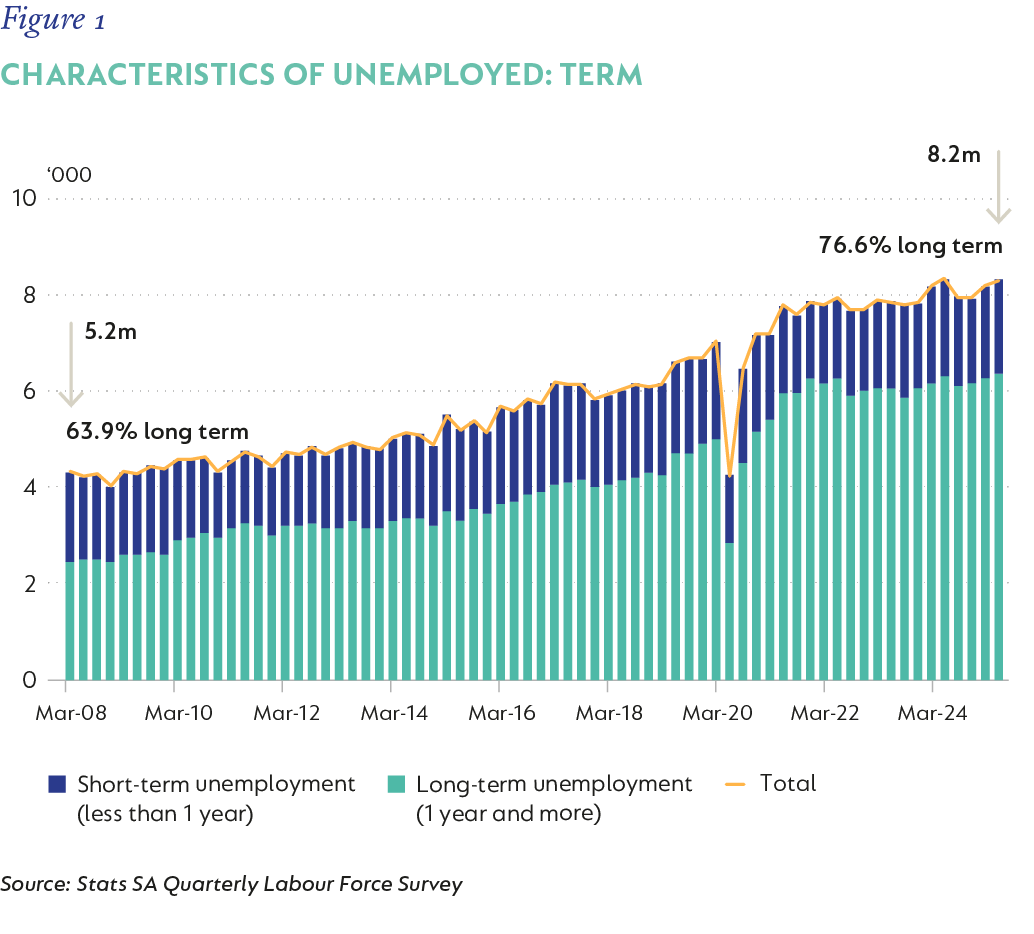
A report published in October by the Centre for Development and Enterprise framed the unemployment crisis thus: “In this period (2008-2025) an average of just over 500 000 people entered the labour market every year, but only 130 000 new jobs were created each year. Put differently, for every person entering the labour force who got a job, four did not. In effect, 1 000 people joined the unemployment queue every day for the past 17 years.”[1]
Multiple structural factors underpin SA’s high unemployment rate – notably the spatial and educational legacy of Apartheid, and the prolonged weakness in domestic growth since 2008. State capture and the declining performance of key economic hubs have also materially constrained GDP growth.
WHY HAS THE ECONOMY STOPPED GROWING?
A long-term growth breakdown
South Africa’s recent economic history, since the end of Apartheid, offers valuable lessons about the drivers of economic growth. In the early years, the economy grew at a healthy pace: between 1995 and 2000, real GDP growth averaged 2.6% - a strong recovery from the 0.2% recorded between 1990 and 1994. From 2000 to 2009 growth averaged about 3.6%, peaking at over 5% between 2005 and 2007. However, this slowed sharply to just 0.7% in the decade from 2015. Outside of the period of peak uncertainty from 1990 to 1994, and Covid-19 and the recovery, this has been the weakest period of growth on record since 1945. In per capita terms, real GDP peaked in 2013 and has been falling ever since – meaning South Africans have been getting poorer, on average, for more than a decade.
Economies can only really grow in three ways – by adding effectively to capital stock, by productively absorbing more people into the labour market, and by combining these capital and labour endowments[2] in more productive ways. This productivity growth enables an economy to grow at a pace more than its potential labour and capital would otherwise accommodate. When successful, this is reinforcing.
Using a standard growth-accounting framework, which decomposes GDP growth into capital (K), labour (L), and total factor productivity (TFP), shows clearly that SA enjoyed a sustained period of broad-based growth between 2000 to 2011, when all three components contributed more than 3% (except in 2009, during the Global Financial Crisis [GFC]) – see Figure 2. Over this period, academic estimates of SA’s ‘potential growth’ – the rate at which the economy has the capacity to grow, given its factor endowment and utilisation – rose to between 3% and 4%. From 2008 onward, however, the picture changes markedly. Most visibly, the labour component shrinks, and the productivity residual collapses.
Between 2000 and 2007, investment, innovation, trade openness, and macroeconomic stability drove efficiency. After 2010, productivity fell across key sectors as capacity collapsed and state-owned enterprises absorbed large amounts of capital without producing commensurate output. Eskom’s capital stock doubled between 2010 and 2019, yet electricity production fell. Mining and construction also lost efficiency as energy and logistics constraints deepened. The economy pivoted toward less-productive sectors – public administration and community services – while output in the rest of the economy contracted.
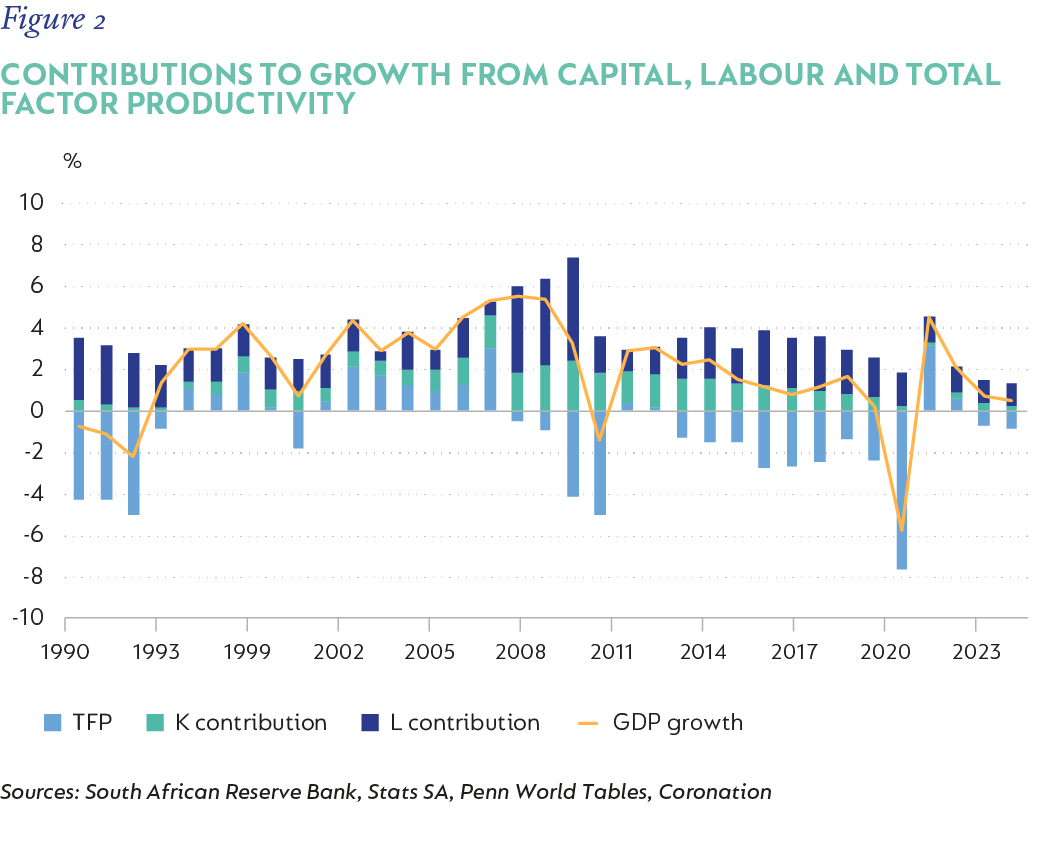
Investment stagnation
Total capital investment ramped up steadily from 1994 to 2008, reaching a peak of 23.3% of GDP in the fourth quarter of 2008. Over the period, there was steady growth across all economic agents, but the private sector at the time accounted for almost 16% of the total. Since that peak, there has been a steady decline in the private sector’s overall contribution, with a trend slowing to below 10%, interrupted only in 2023-2024 when peak loadshedding saw restrictions on generation lifted, and private capital expenditure (capex) into energy picked up. This momentum has since moderated. While the GFC may have shaped near-term private investment decisions, a deterioration in the political environment from 2012 certainly contributed to weaker business confidence and a reluctance to invest.
In their quarterly industry survey, the Bureau for Economic Research asks manufacturers to what degree the prevailing political environment acts as a constraint on their decisions to invest in capital. Figure 3 shows that the proportion of respondents citing politics as a constraint declined steadily up to 2005, reaching a net balance of just 38%. Since 2015, however, this figure has hovered closer to 80%.
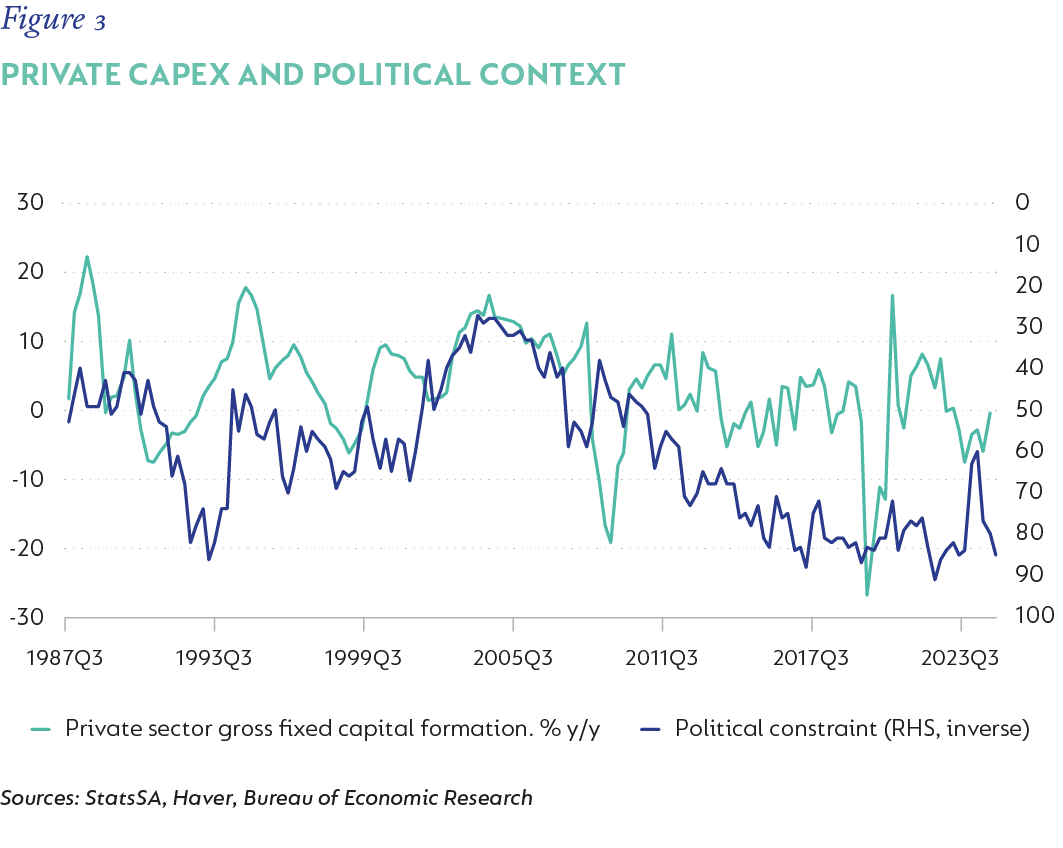
The combined contribution to overall capex in GDP from the government and public entities has fallen from the peak of 7.4% of GDP in 2008 to just below 4% in the latest data.
The labour story is interesting
Comparative data suggests that SA’s labour adjustment during the GFC was extreme relative to the size of the growth shock, and the economy never fully recovered the preceding employment trend.
Figure 4 illustrates this by plotting the peak-to-trough change in real GDP over the GFC (2007-2009) against the total loss of employment from 2008 to 2010 as the crisis rippled across global economies. SA’s position was unusual: while the economic impact over three years was relatively short-lived, the employment loss was comparable to that of Greece, Portugal, and the US – with its notoriously flexible labour market. Looking again at the growth accounting chart (Figure 2), labour accumulation remains positive, but without a recovery to pre-GFC rates.
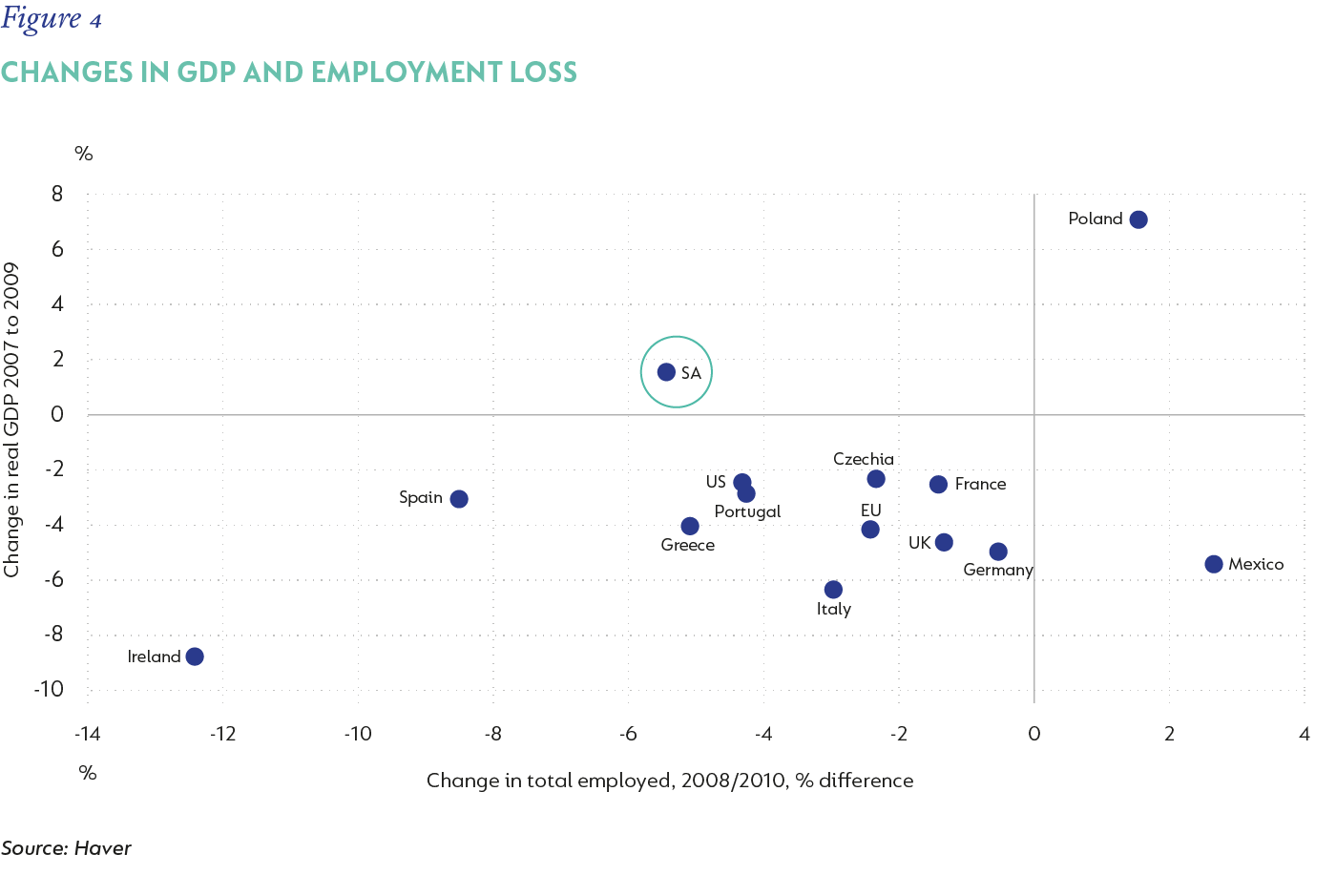
Realised growth rates impact assessments of potential growth – the long-term rate at which an economy can grow given its labour and capital endowments, and the ability to combine these in more productive ways – because the dynamic is reinforcing. For example, sustained periods of employment growth raises the skills level of the aggregate workforce, improving productivity. Similarly, ongoing capital investment not only contributes to employment but can also have positive effects on efficiencies, competitiveness, wellbeing, and productivity.
A FAILING SYSTEM OF HUMAN-CAPITAL FORMATION
A closer look at the labour market dynamics noted in the opening paragraphs is instructive in the context of low employment growth. In particular, understanding the characteristics of the unemployed shows that both low economic growth and underinvestment in human capital – skills development and education - have reinforced the high rate of unemployment. According to Stats SA’s Quarterly Labour Force Survey, more than two-thirds of unemployed people have completed secondary school or less, while those with tertiary qualifications make up about 10% of job seekers (Figure 5). Education is the clearest predictor of employability; it is also the foundation of productivity.
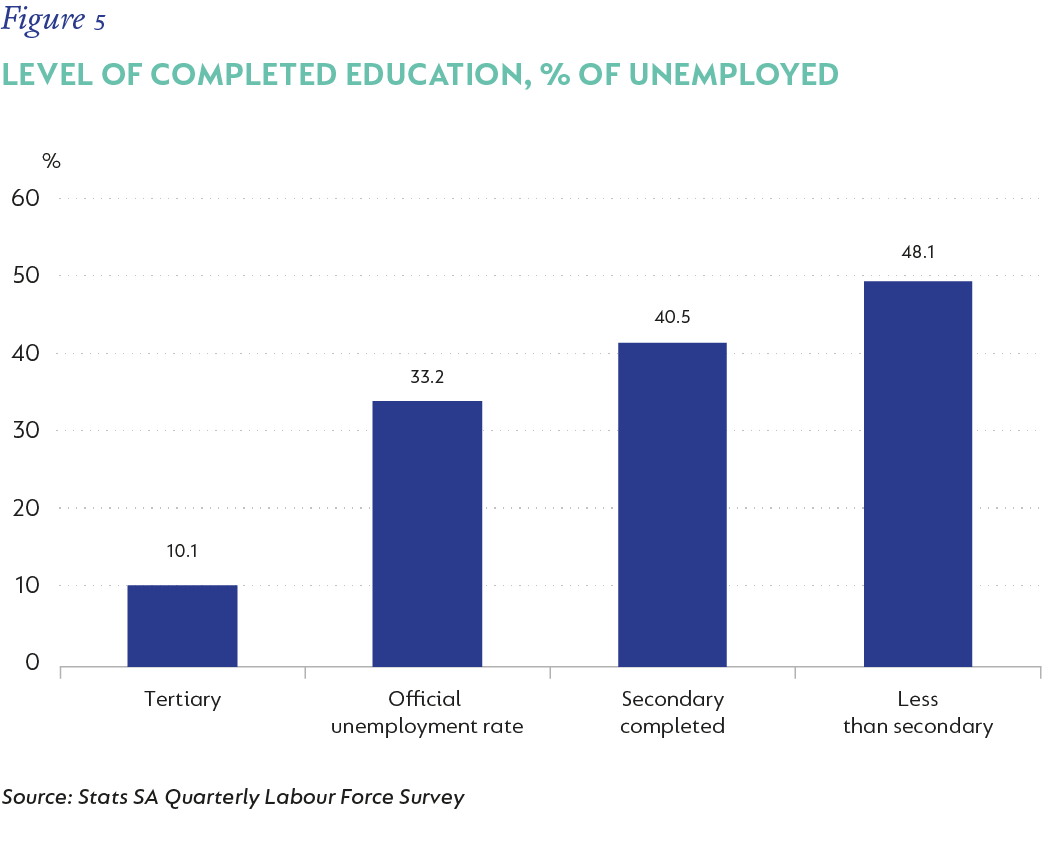
High spending, low returns
Education absorbs roughly 6% of GDP and 20% of government expenditure, placing SA among the world’s highest spenders relative to income. Despite this commitment, outcomes are the weakest among upper-to-middle income peers.
Recent international assessments highlight the depth of the challenge. More than 80% of Grade 4 learners cannot read for meaning[3], and in 47% of secondary schools, no child reached the intermediate maths benchmark[4]. Adjusted for quality, a South African child effectively receives the equivalent of about five years of learning after nine years of schooling.
At the same time, teacher remuneration has risen substantially – by about 66 % in real terms since 2007 – with the average teacher now earning five times GDP per capita, the highest ratio in the OECD dataset.
Research by Peter Courtney (SA-TIED[5] for Operation Vulindlela) shows that learning gaps emerge in the earliest grades: foundational literacy and numeracy determine almost all later educational outcomes. Children who cannot read or count by Grade 4 seldom catch up, regardless of later interventions.
The pandemic deepened these challenges – PIRLS 2023 recorded SA’s largest learning loss globally, erasing a decade of progress.
Figure 6 shows that the link between education, employment, and growth is therefore circular.
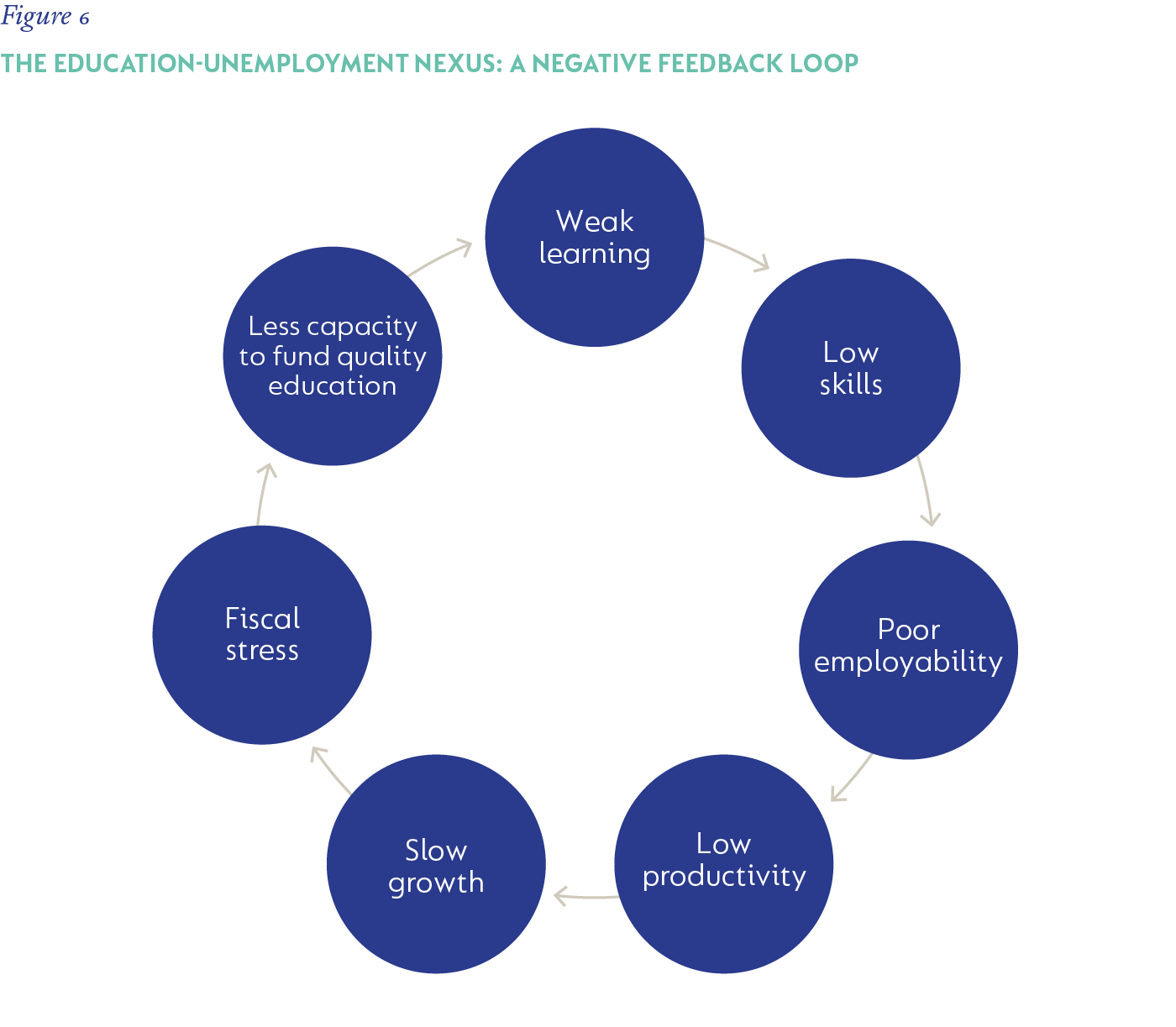
Breaking this cycle requires treating education with the same rigour applied to macroeconomic policy: measurable outcomes, credible accountability, and efficient resource use. A skilled workforce is the multiplier that turns investment into productivity. Education reform is not an adjunct to growth policy; it is growth policy.
Building reason for (cyclical) optimism
While these structural challenges run deep, improving dynamics provide some room for cautious optimism. GDP data posted a welcome lift in Q2-25, with gains in tracking data emerging in the third quarter. The sequential rise in output of 0.8% quarter on quarter (1.1% year on year) in Q2-25 was mostly driven by a rebound in consumer spending, despite weakness in the labour market; low credit growth; and weak confidence. Disappointingly, overall capital investment contracted, due to a steep decline in government investment, which more than offset a modest improvement in spending by the private sector.
Looking ahead, we think some of this momentum will be sustained as real income gains are supported by lower interest rates. It is too early to expect a broad-based recovery in investment while business confidence is still stuck in a rut. However, the incremental easing of logistics and energy constraints helps at the margin, and corporate credit has started to accelerate.
The heady rise in precious and industrial metals prices has also boosted SA’s terms of trade – traditionally a powerful cyclical driver of growth. While the impact has yet to appear in the activity data – mining production has remained weak, raising questions about how much of the price gains have been capitalised - time lags may yet produce a boost to mining output and exports. Improved profitability should also support related tax and royalty revenues.
In addition, we do expect some of the committed capex by the public sector – notably related to energy, transmission, and logistics to be realised over the next two to three years. There will probably be delays, but where plans are advanced (the Renewable Energy Independent Power Producer Procurement Programme), or the private sector has already been engaged (Transnet ports), we have greater confidence that the actual investment will take place.
Our real GDP expectations reflect these dynamics. We see GDP of 1.2% in 2025 accelerating to 1.6% in 2026, with some pass-through of momentum from the end of this year into next. By 2027/2028, we think a period of above 2% is likely, as the public capex materialises, but then, as shown in Figure 7, growth is set to slow again. This highlights that growth momentum remains temporary rather than structural.
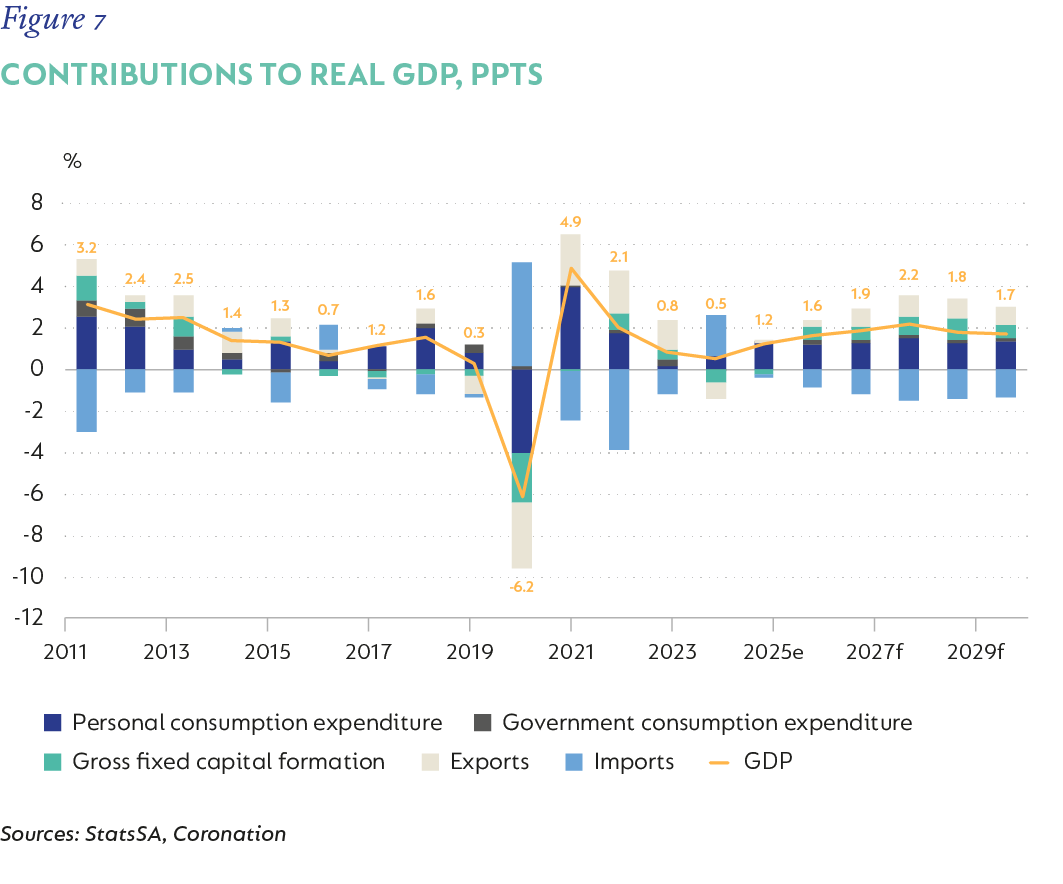
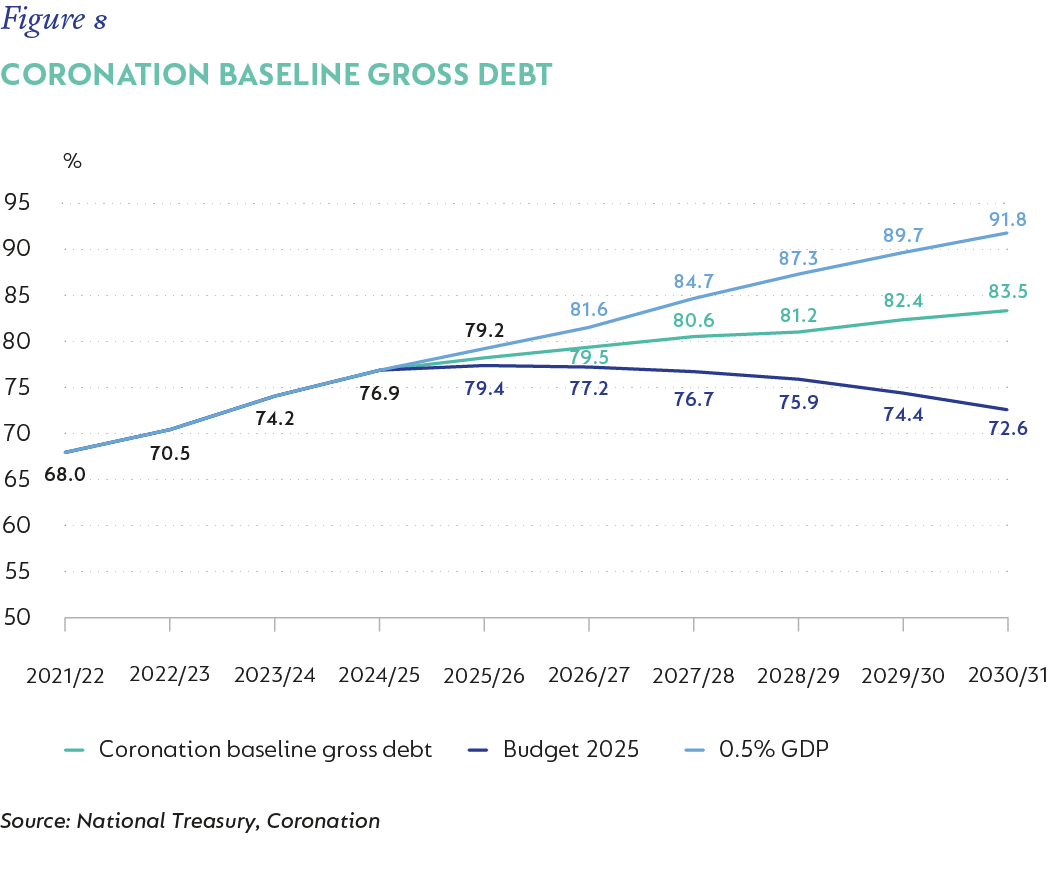
It may be that the rise in near-term growth will be enough to help sustain a more virtuous cycle, aided at the margin by reform rather than the capacity destruction that has characterised the period from 2008. But, while capex remains weak and educational outcomes critical, the economy’s ability to productively absorb labour will remain at the current very low level.
There is a lot of excellent research that offers practical interventions to address this escalating crisis. There is less research quantifying the economic, social, and fiscal impact of not doing so. Laying bare the status quo and understanding the historic drivers of this situation creates an opportunity to intervene. However, if growth remains in the painfully weak 0.5%-1% range – or falters again – current fiscal allocations, even with tough consolidation and a rising primary surplus, will not be sufficient to stabilise the debt trajectory. Figure 8 illustrates this risk: debt continues to rise relative to GDP, crowding out investment, raising borrowing costs, and diverting resources away from social and capital spending.
BOTTOM LINE
South Africa’s unemployment crisis is the visible symptom of a deeper malaise: an economy that has stopped growing and an education system delivering very poor outcomes.
Growth accounting makes the sequence clear – unemployment has risen, investment has fallen, and productivity has collapsed. Behind each lies an erosion of human capital that has become self-reinforcing.
Restoring growth requires rebuilding both capital and capability:
- Investment to expand productive capacity,
- Growth to generate demand, employment, and fiscal space, and
- Education to build the skills base that makes this process self-reinforcing and inclusive.
These are interdependent. Jobs will not return until growth returns — and growth will not sustain until learning does.
[1] Centre for Development and Enterprise, “South Africa’s Unemployment Catastrophe: A Call for Urgent Action,” October 2025
[2] Endowments: a country’s existing labour and capital resources that set the potential for long-term growth
[3] Progress in International Reading Literacy Study (PIRLS), 2023
[4] Trends in International Mathematics and Science Study, 2019
[5] Courtney, Peter SA-TIED “Education, Inclusive growth and fiscal consolidation” February 2025
 South Africa - Personal
South Africa - Personal


